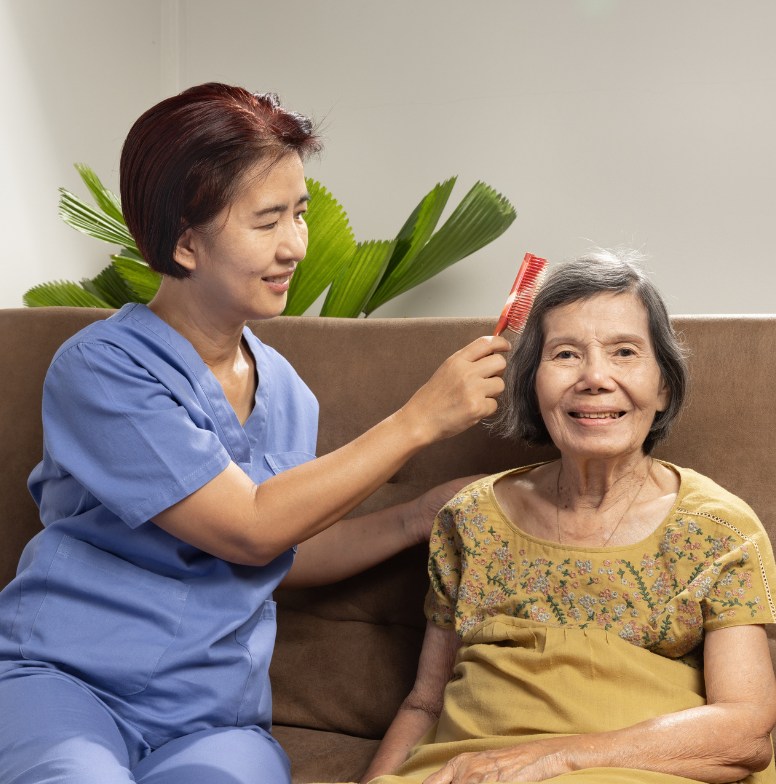Memory loss
Memory loss is one of the most predominant symptoms of Alzheimer’s disease. Individuals may have difficulty recalling recent information or recognizing familiar faces. This creates an urgent need to design the environment in such a way as to compensate for this deficiency, using visual aids and strategic reminders.
Temporal and spatial disorientation
Alzheimer’s sufferers may also have difficulty understanding the passage of time and orienting themselves in space. This can lead to frequent confusion about the time of day, the location of certain rooms in the house, or even the distinction between home and away. Adjustments such as easy-to-read clocks and visual cues are needed to alleviate these problems.

Behavioral changes
Alzheimer’s disease can also cause behavioral changes, such as agitation, irritability or distrust of others. These emotional variations can influence the way a person interacts with their environment. Consequently, the design of the space must take these emotional aspects into account to create a soothing and secure environment.
Visual perception disorders
Impaired visual perception can aggravate confusion and the risk of falling. Changes in the way people with Alzheimer’s perceive their environment can make steps, objects or shadowy areas potentially dangerous. Adaptations such as adequate lighting and the reduction of visual obstacles help to minimize these risks.

Consultation avec des professionnels de la santé
Une collaboration étroite avec des professionnels de la santé, tels que des ergothérapeutes et des médecins spécialisés en gériatrie, est essentielle à la réussite de l’aménagement. Ces experts peuvent fournir des informations précieuses sur les capacités résiduelles du patient et offrir des conseils personnalisés. Leur expertise contribue à la création d’un environnement qui favorise l’autonomie tout en minimisant les obstacles potentiels. La communication régulière avec le personnel médical garantit également une adaptation continue de l’aménagement en fonction de l’évolution de la maladie.
Sécurité avant tout
Évaluation approfondie des risques potentiels dans la maison
La sécurité demeure une préoccupation centrale lorsqu’il s’agit d’aménager l’espace pour une personne atteinte de la maladie d’Alzheimer. Une évaluation approfondie des risques potentiels au sein de l’environnement domestique est impérative. Cette analyse proactive consiste en une identification minutieuse des zones à risque, englobant notamment les escaliers, les salles de bains et les espaces de vie. La mise en place de mesures préventives adaptées découle de cette évaluation, visant à créer un environnement sécurisé qui favorise l’autonomie.
Identification des zones à risque
L’analyse des risques commence par une identification pointue des zones de la maison présentant des dangers potentiels. Les escaliers, souvent sources de préoccupations, nécessitent une attention particulière, tout comme les salles de bains, où les risques de glissade sont accrus. Les espaces de vie, bien que familiers, peuvent également comporter des obstacles qui exigent une intervention proactive.
Mise en place de mesures préventives
Une fois les zones à risque identifiées, la mise en place de mesures préventives devient cruciale. Cela englobe l’installation de rampes robustes près des escaliers, l’ajout de barres d’appui dans les salles de bains pour faciliter les déplacements, et l’utilisation de revêtements antidérapants là où cela est nécessaire. Ces adaptations visent à minimiser les risques de chutes et à promouvoir un environnement sûr et sécurisé.
Adaptations spécifiques pour prévenir les chutes et les accidents
Les chutes demeurent l’une des principales préoccupations en matière de sécurité pour les personnes atteintes de la maladie d’Alzheimer. Ainsi, des adaptations spécifiques doivent être intégrées à la conception de la maison pour prévenir ces incidents indésirables.
Installation de rampes et de mains courantes
Dans les maisons à étages, l’installation de rampes solides et de mains courantes le long des escaliers offre un soutien crucial pour la personne atteinte d’Alzheimer. Cela facilite les déplacements en réduisant les risques de chutes et en offrant une assistance constante.
Revêtements antidérapants et éclairage adéquat
Les revêtements antidérapants sur les surfaces glissantes, tels que les sols des salles de bains, sont essentiels. De plus, un éclairage adéquat dans toute la maison contribue à minimiser les zones d’ombre et à améliorer la visibilité, réduisant ainsi le risque d’accidents. Vous pouvez découvrir les sols de Plancher Newlook, qui propose des services de restaurant de parquet à mascouche, la finition de planter et d’escalier de bois.
Réduction des obstacles inutiles
La réduction des obstacles inutiles dans les espaces de vie contribue également à prévenir les chutes. En éliminant le superflu, l’espace devient plus facile à naviguer, offrant à la personne atteinte d’Alzheimer un environnement plus sûr et plus contrôlable.
En mettant en œuvre ces adaptations spécifiques, l’aménagement de la maison devient un moyen proactif d’assurer la sécurité et le bien-être de la personne atteinte de la maladie d’Alzheimer, tout en offrant une tranquillité d’esprit aux membres de la famille et aux soignants.
Création d’un environnement familier
Utilisation de repères visuels et de signes de reconnaissance
La création d’un environnement familier est essentielle pour le bien-être émotionnel et mental des personnes atteintes de la maladie d’Alzheimer. L’utilisation judicieuse de repères visuels et de signes de reconnaissance contribue à atténuer la confusion et à favoriser un sentiment de sécurité.
Repères visuels dans les espaces communs
Intégrer des repères visuels dans les espaces communs de la maison est crucial. Cela peut inclure des photos de famille, des tableaux mémoires avec des événements clés, ou même des étiquettes simples pour identifier les pièces. Ces éléments visuels aident à créer une ambiance familière, stimulant la mémoire et fournissant des indices contextuels.
Utilisation de signes de reconnaissance personnels
En plus des repères visuels, l’introduction de signes de reconnaissance personnels renforce le sentiment de familiarité. Des objets significatifs, tels que des meubles ou des décorations auxquels la personne est attachée, servent de rappels tangibles de son passé. Ces éléments contribuent à maintenir un lien émotionnel avec l’environnement.
Organisation logique des espaces pour minimiser la confusion
L’organisation logique des espaces est un élément clé pour minimiser la confusion chez les personnes atteintes de la maladie d’Alzheimer. Une disposition claire et cohérente des pièces et des meubles facilite la navigation et réduit les risques de désorientation.
Rationalisation des espaces de vie
Rationaliser les espaces de vie en évitant les agencements complexes et en limitant le nombre de meubles contribue à créer un environnement plus compréhensible. Les pièces dégagées et bien éclairées favorisent une circulation aisée, réduisant ainsi le stress associé à la recherche d’objets ou à la navigation dans la maison.
Organisation logique des objets du quotidien
L’organisation logique des objets du quotidien, tels que la vaisselle, les vêtements, et les articles de toilette, simplifie les activités quotidiennes. Placer les objets fréquemment utilisés à des endroits accessibles favorise l’autonomie et réduit la frustration liée à la recherche d’articles essentiels.
En créant un environnement familier et bien organisé, l’aménagement de la maison pour une personne atteinte de la maladie d’Alzheimer contribue à maintenir un sentiment de normalité et de confort. Ces ajustements favorisent non seulement l’indépendance au quotidien, mais renforcent également le lien émotionnel entre la personne et son domicile.
Simplification de l’espace
Réduction du nombre d’objets et de meubles
La simplification de l’espace est une approche cruciale dans l’aménagement de la maison pour les personnes atteintes de la maladie d’Alzheimer. La réduction du nombre d’objets et de meubles contribue à minimiser la confusion et à créer un environnement plus facile à naviguer.
Élimination des objets non essentiels
Une première étape consiste à éliminer les objets non essentiels qui peuvent ajouter à la complexité de l’espace. Cela peut inclure des bibelots encombrants, des meubles superflus ou des décorations inutiles. La simplicité visuelle facilite la concentration et réduit le risque de surstimulation.
Priorisation des objets significatifs
Dans le processus de réduction, il est important de prioriser les objets significatifs pour la personne atteinte de la maladie d’Alzheimer. Les éléments qui évoquent des souvenirs positifs ou qui ont une valeur émotionnelle devraient être préservés. Cette sélection intentionnelle contribue à maintenir des liens avec le passé et à créer un environnement plus personnalisé.
Choix de couleurs apaisantes et de textures simples
Le choix de couleurs apaisantes et de textures simples est un aspect crucial de la simplification de l’espace. Une palette de couleurs douces et cohérentes, ainsi que des textures simples, favorise une ambiance calme et accueillante, créant un environnement propice au bien-être.
Couleurs pour créer une atmosphère sereine
Les couleurs influent sur l’humeur et le comportement. Opter pour des tons apaisants tels que le bleu, le vert ou le beige peut créer une atmosphère sereine. Éviter les contrastes trop forts et privilégier une palette de couleurs cohérente dans toute la maison offre une expérience visuelle plus agréable.
Textures simples pour réduire la surstimulation
Les textures simples, que ce soit pour les revêtements de sol, les meubles ou les textiles, contribuent à réduire la surstimulation sensorielle. Des surfaces lisses et des tissus doux favorisent le confort tout en minimisant les distractions visuelles et tactiles.
En simplifiant l’espace à travers la réduction d’objets, le choix de couleurs apaisantes et de textures simples, l’aménagement de la maison devient plus adapté aux besoins des personnes atteintes de la maladie d’Alzheimer. Ces ajustements favorisent un environnement harmonieux, réduisent les sources potentielles de confusion et améliorent la qualité de vie au quotidien.
Using technology to make daily life easier
Integration of intelligent safety devices
The integration of intelligent safety devices represents a significant step forward in home design for people with Alzheimer’s disease. These technologies offer unobtrusive surveillance and enhanced security.
Remote monitoring systems
Remote monitoring systems enable relatives and caregivers to discreetly monitor activity in the home. Connected cameras with night vision capabilities offer peace of mind through non-intrusive surveillance.
Motion and safety sensors
Motion and security sensors can be strategically installed to detect movement and unusual activity. These devices can trigger alerts in the event of potentially dangerous situations, such as an unplanned night out.

Applications and technological aids for memory and routine
Applications and technological aids play a crucial role in supporting the memory and daily routine of people with Alzheimer’s disease.
Reminder and organization applications
Specially designed applications can send visual or audible reminders to help you stick to your daily routine. These digital tools can include to-do lists, medication reminders and instructions for daily activities.
Voice assistance devices
Voice assistance devices, such as smart speakers, can be programmed to provide useful information and verbal reminders. They offer assistance in managing day-to-day tasks while encouraging independence.

Other articles that might interest you:
No Results Found
The page you requested could not be found. Try refining your search, or use the navigation above to locate the post.




